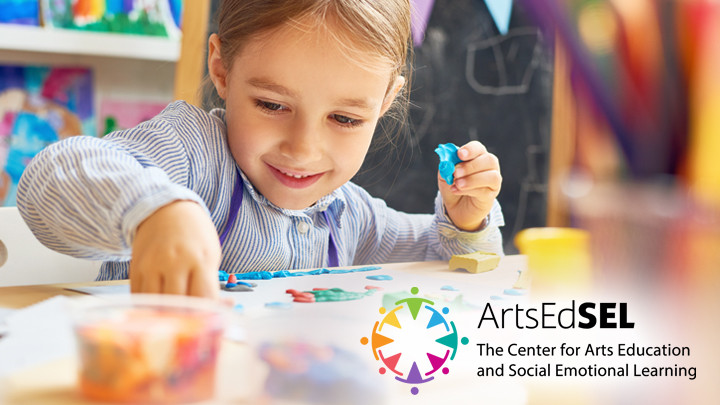Arts Ed NJ, an arts education organization in New Jersey, recently launched The Center for Arts Education and Social Emotional Learning (ArtsEdSEL), a national organization dedicated to illuminating the intersection between arts education and social-emotional learning (SEL) to facilitate the embedded, intentional, and sustained application of SEL-informed arts education.
Read an interview with Bob Morrison, executive director of ArtsEdSEL, below.
Q: What is The Center for Arts Education and Social Emotional Learning (ArtsEdSEL)?
Bob: ArtsEdSEL builds capacity to facilitate arts education enriched by SEL, and fosters a new vision for SEL within the context of artistic works. This is accomplished by elevating the lived experience, voices, and cultural assets of PreK-16 students through the development of exemplary arts education practices and approaches, designed to activate the SEL competencies of self-awareness, self-management, social awareness, relationship skills, and responsible decision-making through the artistic processes of create, perform, respond, and connect. ArtsEdSEL supports practices related to the development of student artists’ IDENTITY, BELONGING, and AGENCY through the arts.
By shaping curriculum, supporting teacher practice, and furthering the arts education and social-emotional learning research agenda, ArtsEdSEL builds capacity for high-quality arts education, grounded in culturally- responsive, relevant, and sustaining practices that will embrace the needs of diverse student populations.
Q: Why did you feel it was important to create the Center for Arts Education and Social Emotional Learning (ArtsEdSEL)?
Bob: Inspired by a meeting of the SEL4NJ leadership in the fall of 2018, Arts Ed NJ began wrestling with the question, “How do arts educators intentionally connect SEL to their work in the arts classrooms?” Since New Jersey was in the process of revising the state’s visual and performing arts standards (based on the National Core Arts Standards and the artistic processes of Creating, Performing, Responding and Connecting) and, since the New Jersey State Department of Education had already adopted competencies for SEL (including the five CASEL competencies of Self- Awareness, Self-Management, Social Awareness, Relationship Skills and Responsible Decision Making as well as 19 sub-competencies divided between them) in 2017, the SEL and Arts Education Taskforce developed a crosswalk between these two documents to create a blended and intentional way to consider both the SEL competencies and the New Jersey’s Student Learning Standards in the Visual and Performing Arts to coincide with the statewide curricular revision and adoption created by the release of the new standards. The result of this work was New Jersey’s Arts Education and Social and Emotional Learning Framework.
As we were developing this Framework it became clear the New Jersey was emerging as a leader in this area and through our own research found that there was no real central organizing entity for this topic. So building off of our work developing the Framework we decided to create this new Center to serve as the center of gravity for this area of work.
By shaping curriculum, supporting teacher practice, and furthering arts education and social-emotional learning research, ArtsEdSEL will positively impact the entire educational landscape.
Q: Please tell us about your work on SEL, and why is it so important for going back to school?
Bob: SEL was emerging as a priority for education in this country even prior to the COVID-19 pandemic. This focus was driven in large part by the significant increases we were seeing in student anxiety and stress, rising rates of teenage suicides, school shootings, and the negative impact of social media. Schools were already prioritizing student wellness and mental health. The pandemic just put booster rockets on the issue and sent it into the stratosphere. The result is that SEL will be the number one priority as our schools come back into session across the nation.
Our students have gone through tremendous trauma. They have missed out on so much over the past year. As educators, we have to recognize this and must prepare to support our students. Allow them to express themselves, find their safe space again in school, be creative and find that sense of belonging again. All of this can be done well through the arts. I would argue that arts education is uniquely positioned to address the SEL needs of our students. By their very nature… music and the arts are social. Just look at any art classroom. And the arts are emotional. The key is to be intentional about who we unlock the SEL components through art instruction.
Q: What resources are available to educators?
Bob: One of our priority areas was to create and curate the best resources available on the subject to support arts educators. Not only do we have the Arts Education and Social-Emotional Learning Framework as a tool for arts educators to use in revising curriculum and developing lesson plans, but we also have an extensive collection of the best research, articles, webinars and teaching materials on our website. The resource section is designed to allow educators to easily find the relevant information they are looking for. In addition, we publish monthly briefings, quarterly newsletters, and topical webinars bringing together the best researchers, policymakers and partitioners to share the latest information on arts-infused SEL. We will also be commissioning SEL-infused artistic works over the next several years for use in education.
Q: How can someone get involved?
Bob: The best way to get involved is to visit our website, sign up for our email communications, explore all the information and resources, and then reach out to our team to get involved or for support in implementing SEL in the classroom.

